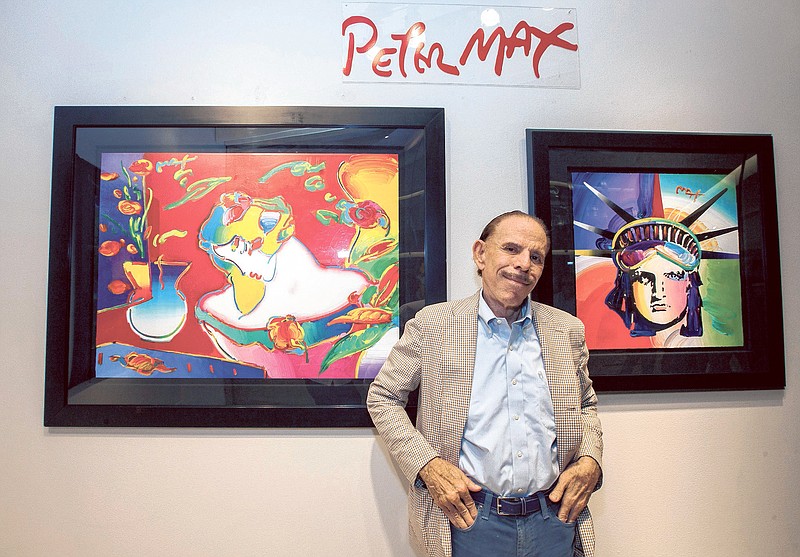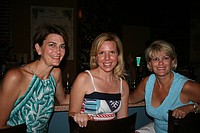IF YOU GO
Some of Peter Max's art can be found at Music City Fine Art, 219 Fifth Ave. N., Nashville. Hours: 11 a.m.- 6 p.m. Tues- day-Saturday. 931-313-9613.
Peter Max sits in his New York studio on West 65th Street, doing a telephone interview while staring at the walls, which he says are covered top to bottom with more than 120 magazine covers bearing images of some of the biggest celebrities in the world.
They are a fraction of the more than 2,200 covers he's done over the years, he says.
"It's amazing," he says in his distinctive voice that bounces from European to Bronx-tinged in the same sentence. "I'm looking at a wall right now in my studio with all these magazine covers. I'm looking at The Beatles, Ringo [Starr], George [Harrison], John Lennon. I have three [Paul] McCartney covers. David Bowie, Frank Sinatra."
There is more glee in his voice than brag, as he reflects on the incredible career he's had. Max, 78, has helped define culture and art since the mid-'60s. His works have appeared on postage stamps, the entire exterior of a Boeing 777, a 600-foot stage at Woodstock in '69 and on magazine covers. Lots of magazine covers.
And he's still doing exactly what he wants to be doing.
"Every day I come to work -- I live four or five blocks away -- the adrenalin starts because I know any minute I'm going to be in my studio. When I get there, I lift up the top [off of the paints] and I have 77 colors and about 100 brushes so you can imagine every color in the world.
"The canvases are blank, though sometimes I prepaint them, and then one of my assistants puts on some music and boom, the music plays, I take off my jacket and put my apron on. I dip my brushes and tip into one of the colors -- maybe red or maybe blue -- I don't even know what I'm doing and eventually when I put colors on the canvas I turn it into something.
"The thrill is surprising myself, but yet at the same time I have the skill to make nice things."
A retrospective of Max's work was recently exhibited in Nashville at Music City Fine Art and some of the pieces remain on permanent display at the Music City Fine Art gallery on Fifth Avenue North. He does dozens of such shows each month all over the world, he says.
"It's something I enjoy doing," he says. "I love Nashville. It has so much music."
Max is known for his bold colors, as well as the diversity and breadth of his works. He has painted for six presidents, the U.S. Olympic Team, five Super Bowls, the World Series, the U.S. Open, the Indy 500, the Kentucky Derby, America's Bicentennial. He also he did a Statue of Liberty series that helped raise money for its restoration. The U.S. Postal Service commissioned him to paint the first 10-cent stamp in conjunction with Expo '74 World's Fair.
"When they asked me, I said 'Oh my god,'" he says of the stamp. "When I was a kid I was a stamp collector. They used it for about four years. I would go to a gallery and people would give me envelopes to sign."
Max was born in Berlin in 1937 and has lived in Shanghai, China, Israel, Paris and Tibet as a child. After displaying a similar love for drawing as his father, his mother made sure he had an art tutor wherever they lived.
After high school, he attended the Art Students League of New York in Manhattan and was taught by Frank Reilly, a former classmate of Norman Rockwell's at the same school. Max thought he would focus his career on realism, but "I wasn't really into realism." He opted to take up a style and form he had experimented with years earlier in Asia and found his voice.
He opened an arts studio with Tom Daly and mentor Don Rubbo and the three worked on books and advertising that earned them a good deal of recognition. Max distinguished himself with his "Cosmic '60s" series, which became identified with the psychedelic, counterculture crowd.
His art found its way into TV commercials, most notably one that touted 7-Up as the "Uncola." The works made him a celebrity.
These days, he says he's never sure what his finished pieces will look like, but he compares the exercise to taking a walk in the park.
"Sometimes you go to the left and sometimes you go to the right. Either way, it is always different."
Contact Barry Courter at bcourter@timesfreepress.com or 423-757-6354.

